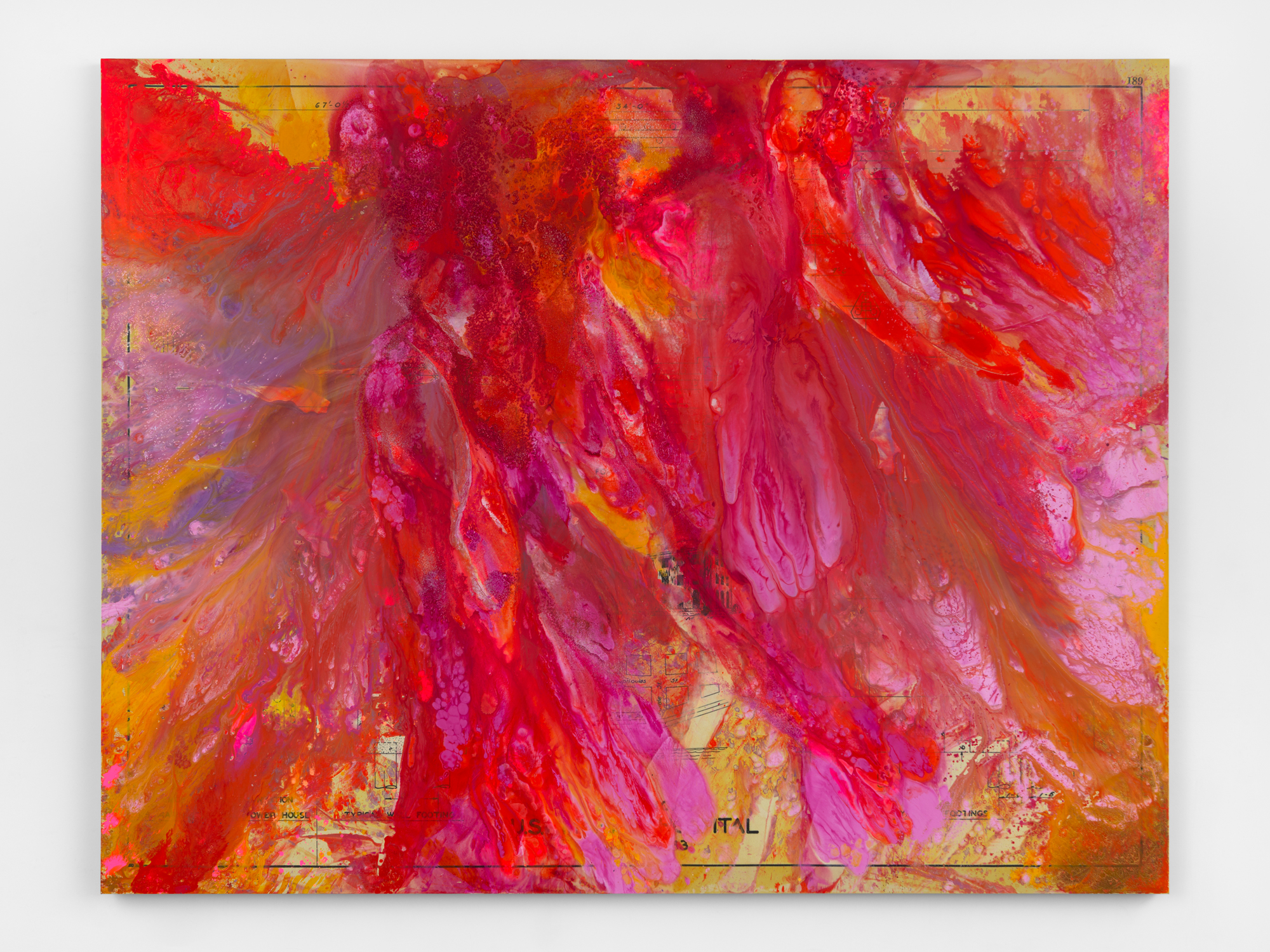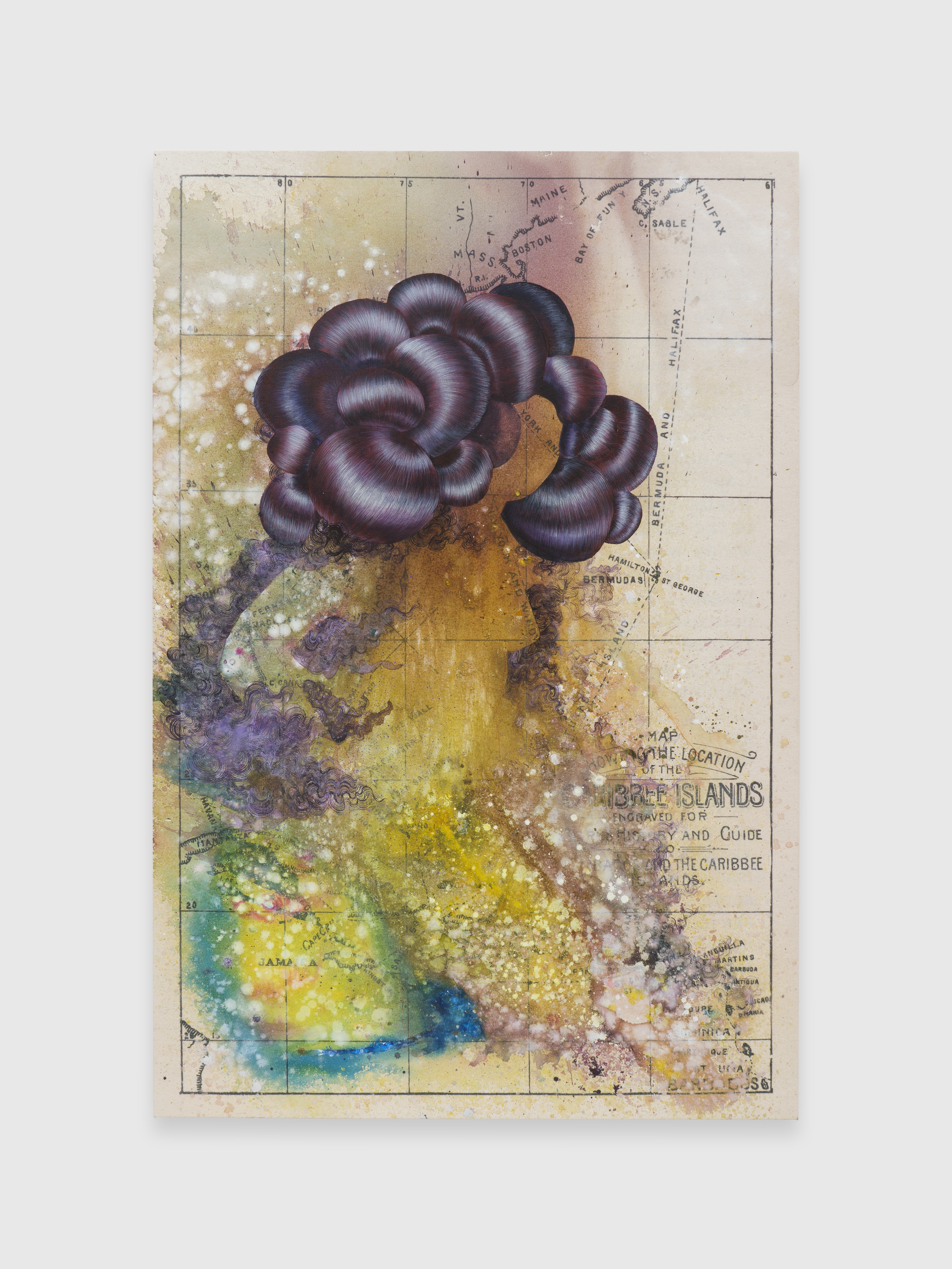Welcoming Firelei Báez to Hauser & Wirth

Photo: Amilcar Navarro
Welcoming Firelei Báez to Hauser & Wirth
We are pleased to announce global representation of New York–based artist Firelei Báez (b. 1981, Dominican Republic). Báez has achieved wide acclaim over the past decade for her immersive paintings, installations and sculptures that explore diasporic histories against the backdrop of colonial narratives and conventional ways of seeing.
A self-described bibliophile and voracious reader, Báez has been likened to a historian, mining the foundational and forgotten archives of the Americas and beyond in order to challenge and expand the ways in which we perceive and relate to one another. Her constructions are marked by erudition and an intimate physicality that gives way to vibrant abstraction and exquisite detail. Though richly layered in cultural and historical references, her practice is equally rooted in a palpable connection to the human body—her own and that of the viewer. Báez’s sensitivity to the conditions within which she creates extends to the physical experience of looking at her work. The visceral abstractions, multisensory approach and arresting beauty of her art capture the viewer on a deep intuitive level before conceptual understanding coalesces, catalyzing a sensory reorientation where new ways of perceiving and imagining become possible.
Báez’s reinterpretation of the past achieves complexity and nuance beyond the confines of traditional historical accounting. She incorporates archival elements that have been discarded or overlooked in order to create what she describes as ‘a bigger truth.’ In her work, antiquated maps, architectural blueprints and the pages of deaccessioned books become the literal canvases upon which the artist intervenes. Paint pours, graphic patterns and three-dimensional renderings disrupt the original composition of these documents. From such initial abstractions, fantastical figures and worlds emerge; hybrid forms of human and animal bodies entwine with verdant plant life, delicate hair arrangements and elaborate textile designs. Saturated colors ebb and flow within these precise depictions, resulting in an expansive and fluid representation of the body and history. Through her multimedia installations, Báez’s virtuosic paintings take on a third dimension, extending into monumental architectural forms and soundscapes, further enveloping viewers in her mythmaking and avid prospecting of new worlds.

Marine Hospital, 2021, acrylic and oil on archival printed canvas, 97 3/4 x 125 3/4 / 248.3 x 319.5 cm © Firelei Báez. Photo: Phoebe d'Heurle
‘Firelei takes on history and transforms it into poetry—visual, visceral, technically inventive, breathtaking works of art that go beyond merely telling us something, to fully enveloping and implicating us,’ says Marc Payot, President, Hauser & Wirth. ‘By consistently reasserting the importance of the Caribbean in the wider context of world history and revealing the pervasive presence and impact of Caribbean and Black cultures that have been previously obscured, her art demands we become more astute world citizens. In her courage and sheer virtuosity, Firelei aligns perfectly with so many pathbreaking artists in our gallery's program. We're thrilled and honored to welcome her to Hauser & Wirth and look forward to all that lies ahead in our collaboration.’

Map of the British Empire in America, 2021, acrylic and oil on archival printed canvas, 96 7/8 x 132 1/4 x 1 5/8in / 245.9 x 335.8 x 4 cm ©Firelei Báez. Photo: Phoebe d'Heurle

Chrono-DREAMer, 2019, acrylic and oil on archival printed canvas, 72 x 48 in / 182.9 x 121.9 cm ©Firelei Báez. Photo: Jackie Furtado
About the artist
Firelei Báez was born in Santiago de los Caballeros, a city bordering Haiti in the Dominican Republic, in 1981. Informed by having a Dominican mother and father of Haitian descent, Báez’s early sense of place and belonging deepened once she relocated to Miami, Florida at the age of eight years old. From a very young age, art had become an essential source of expression for Báez, as did reading and maintaining a collection of books. Instinctively aware that formal historical categories limit imagination, perception and identity, Báez has since used her art to explore what she calls ‘the freedom of decategorization.’ Consistently pushing the boundaries of established knowledge, Báez combines the rigor of a historical researcher with the worldmaking capacity of a storyteller. Mythology is an important tool for Báez, ‘a way of correcting the past and projecting a different future.’ A generative and recurring figure in her work is the ‘ciguapa,’ a mythic femme creature from Dominican folklore known for her trickery and elusiveness. A multidirectional being characterized by mutability, the ciguapa has feet that point in opposite directions, an attribute that allows her to never be traced. Growing up in the Dominican Republic, Báez heard ciguapa stories intended as cautionary tales against unvirtuous and wild behavior. As someone deeply curious about both ‘the risks and...gains of belonging and not belonging,’ she has held onto her fascination with this mythological being and to the trickster, an archetype that, as curator Julie Crooks has noted, takes on a political valence in Báez’s work as a means or pathway to new freedoms.
Báez seeks to understand why and how histories are constructed and deconstructed. For example, in her 2014–15 installation, ‘Man Without a Country (aka anthropophagist wading in the Artibonite River), Báez uses miniscule drawings and tiny markings to adorn the surfaces of hundreds of deaccessioned book pages, demanding exceptionally close physical proximity from the viewer. By virtue of being unprotected by glass or glaze, this work foregrounds the physical act of seeing and the consequences of doing so: the breath or heat from viewers’ bodies accumulated to slowly degrade the material composition of the paper.

Le Jeu Du Monde, 2020, acrylic and oil on archival printed canvas, 105 x 131 3/4 x 1 5/8 in / 266.7 x 334.5 x 4 cm ©Firelei Báez.Photo: Phoebe d'Heurle

Temple of Time, 2020, acrylic and oil on archival printed canvas, 94 1/2 x 132 3/8 x 1 5/8 in / 240 x 336.2 x 4 cm © Firelei Báez. Photo: Phoebe d'Heurle
In her largescale paintings, Báez takes on disavowed histories, often beginning a work by pouring paint over the surface of an enlarged reproduction of an archival document. The shape her pour takes and the way in which it spreads within a particular environment guides the artist’s initial interaction with the foundational artifact, connecting it to her body, time and space. Báez describes the temporal dimension of this pouring process as follows: ‘There's the tilt of the floor, the humidity level, what I could physically reach. These are very specific limitations that become like archaeological time capsules.’ Her pours and other visual interventions allow the contemporary to come into contact with a distant past that still profoundly shapes our language and perception. Through these encounters, Báez opens the doors to a clearer understanding not only of the past’s horrors, but also the enduring persistence of beauty, resistance, and healing.
Báez proposes through her art that we actively participate in the making of history to imagine different futures. She has said, ‘Making connections between seemingly disparate ways of working and histories is one of the best parts of being a visual artist. This often necessitates seeing history not as a linear process, but rather a series of repeating or overlapping patterns.’ By destabilizing historical narratives, Báez allows for a different kind of historical measure, one which embodies the intricate entanglement of opposing forces. Her work is corrective; it makes space for the stories and people who have been erased or excluded from dominant narratives.
Firelei Báez received an M.F.A. from Hunter College, a B.F.A. from the Cooper Union’s School of Art, and studied at the Skowhegan School of Painting and Sculpture. Her work has been presented in many significant international exhibitions, including the inaugural installation of the ICA Watershed, Boston (2021), curated by Eva Respini, now on view at The Momentary in Bentonville, Arkansas, and The Milk of Dreams at the 59th Venice Biennale (2022), curated by Cecilia Alemani. Recent solo presentations of Báez’s work include exhibitions at Witte de With Center for Contemporary Art, Rotterdam; The Museum of Modern Art, New York; The Studio Museum in Harlem, New York; The Andy Warhol Museum, Pittsburgh; and Pérez Art Museum Miami. The artist has recently participated in a number of group exhibitions at major institutions, such as the National Gallery of Art, Washington, DC; Cleveland Museum of Art; Art Gallery of Ontario, Toronto; Baltimore Museum of Art; and Rockbund Art Museum, Shanghai. She is the recipient of many awards, most recently the Cooper Union President’s Citation (2022), Artes Mundi Prize (2021), and Philip Guston Rome Prize (2021). Báez’s work is held in many significant private and public collections; the latter include the Baltimore Museum of Art; Crystal Bridges Museum of American Art, Bentonville, AR; Dallas Museum of Art; Fine Arts Museums of San Francisco; Guggenheim Abu Dhabi; Institute of Contemporary Art, Boston; The Marieluise Hessel Collection, Hessel Museum of Art, Center for Curatorial Studies, Bard College, Annandale-on-Hudson, NY; Nasjonalmuseet, Oslo; Pérez Art Museum Miami; San Francisco Museum of Modern Art; Sindika Dokolo Foundation, Luanda, Angola; Solomon R. Guggenheim Museum, New York; The Studio Museum in Harlem, New York; Tate, London; and Whitney Museum of American Art, New York.
Related News
1 / 5




